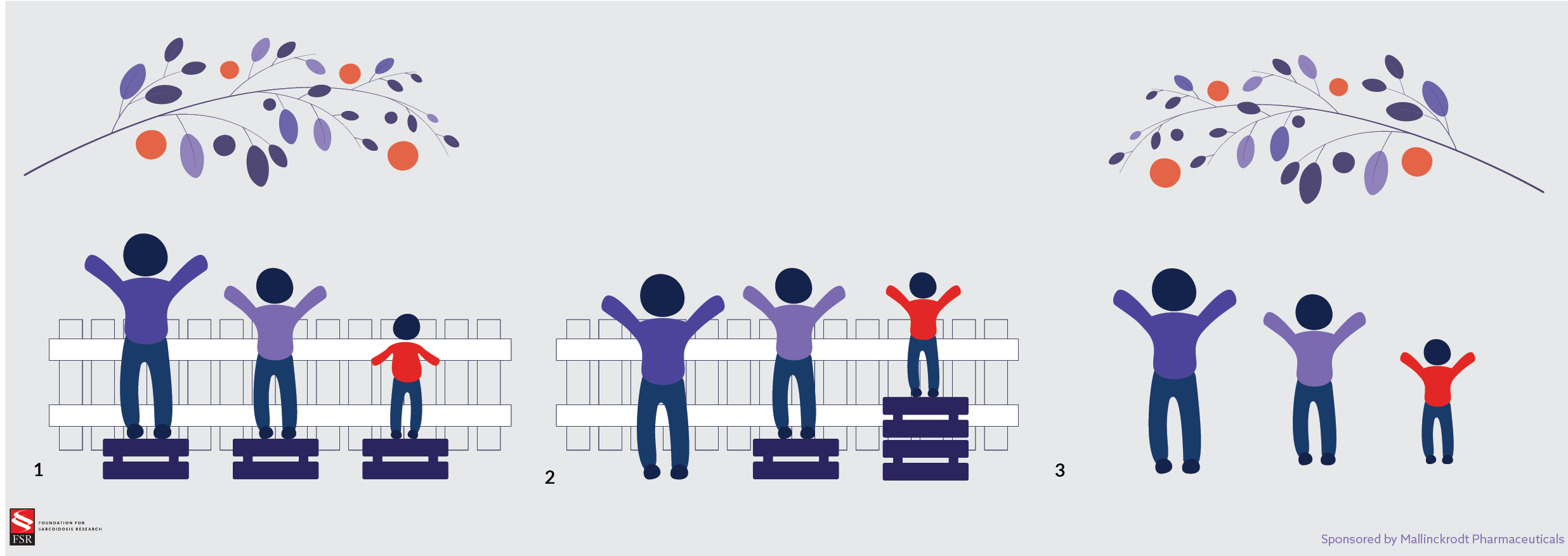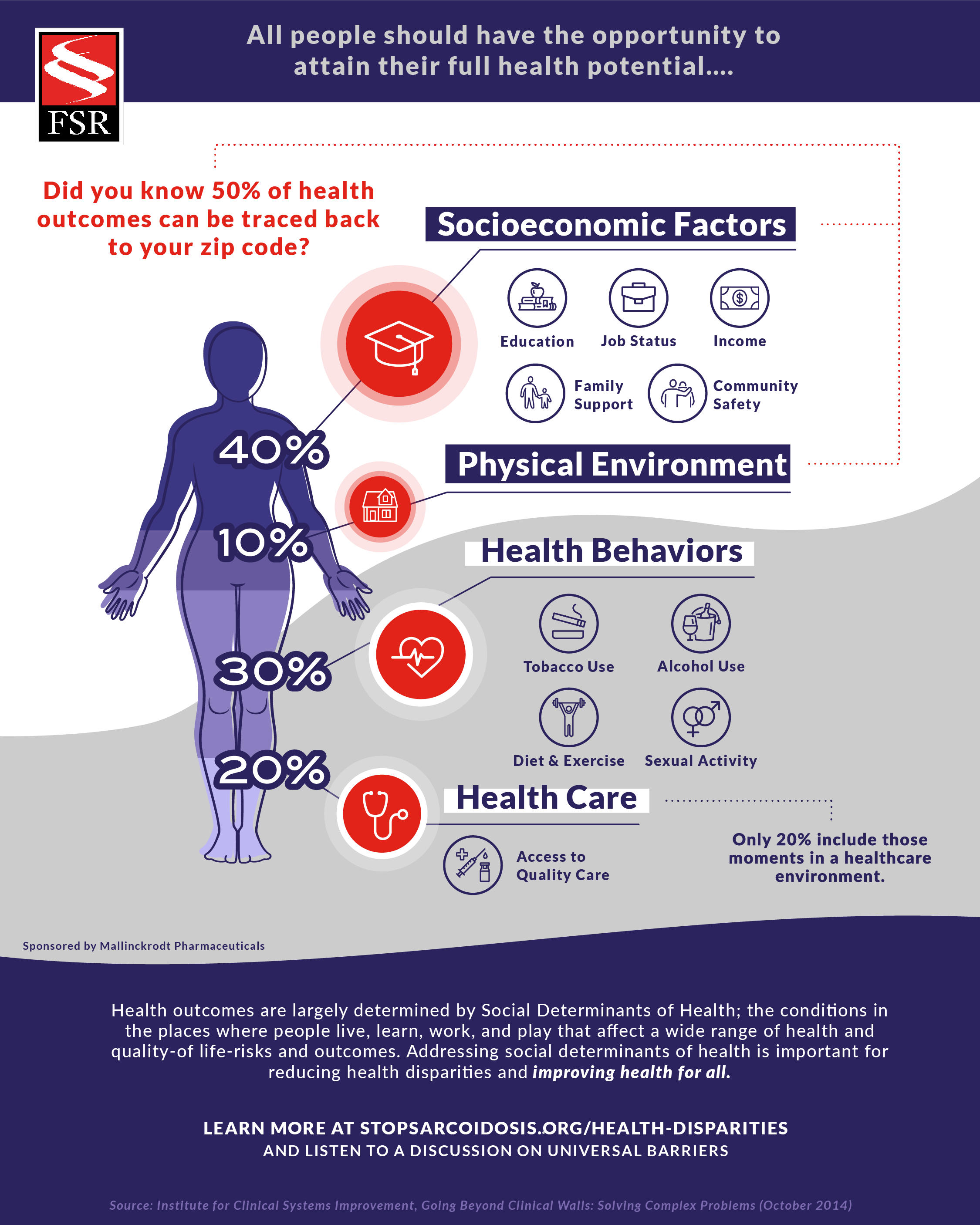Webinar: Universal Barriers in Dealing with a Chronic Disease - Sarcoidosis Perspective
Watch this video to hear from Dr. Ennis James, FSR sarcoidosis expert, and FSR patient advocates, Chasta Posey, Jim Kuhn, and John Carlin, as they discuss the universal barriers experienced by chronic disease patients.
Health Disparities
Patients across the country, from all demographics, experience barriers to care, but when you have a chronic disease, it is even more critical when these barriers prevent you from receiving the best care and optimal health outcomes. Health outcomes are largely determined by Social Determinants of Health (SDOH), the conditions in the environments where people live, learn, work, and play that affect a wide range of health and quality of life-risks and outcomes. The Social Determinants of Health influence our health in positive or negative ways and are key contributors to health disparities.
What are Health Disparities?
The Centers for Disease Control and Prevention (CDC) defines health disparities as, “preventable differences in the burden of disease, injury, violence, or opportunities to achieve optimal health that are experienced by socially disadvantaged populations.”
Health disparities adversely affect groups of people who have systematically experienced greater obstacles to health based on their racial or ethnic group, religion, socioeconomic status, gender, age, mental health status, cognitive, sensory, or physical disability, sexual orientation or gender identity, geographic location and/or other characteristics historically linked to discrimination or exclusion.
How do Social Determinants of Health factors affect health outcomes?
Social Determinants of Health include education, job status, income, family support, community safety, physical environment, and access to quality care. Barriers associated with these factors make it more difficult for people to receive adequate care, disproportionately affecting certain groups more than others. These groups experience worse health outcomes and a disproportionate burden of disease.
Healthy People 2030 uses a place-based framework that outlines five key areas of Social Determinants of Health: Education, Economic Stability (Job status and Income), Neighborhood & Built Environment (Community Safety & Physical Environment), Social & Community Setting, Health Care Access & Quality Care. Click on each area below to read more.
What can be done to address health disparities?
To achieve health equity, obstacles to health must be removed. All people should have the same opportunity to attain their full health potential, and no one should be disadvantaged from achieving this potential. The pathway to eliminating health disparities is one that requires significant overhauls of existing social structures and policies which require stakeholders across the spectrum - from health organizations to government agencies - to work in tandem to address Social Determinants of Health. However, addressing and reducing health disparities can be achieved through targeted interventions, programs, and policies.

Equality (1): The assumption is that everyone benefits from the same support. However, everyone can't see over the fence.
Equity (2): Everyone gets the support they need, so everyone can see over the fence.
Justice (3): Everyone can see because the cause(s) has been addressed. The systemic barrier has been removed.
Pursuing health equity means eliminating health disparities and striving for the highest possible standard of health for all people - giving special attention to the needs of those at greatest risk of poor health, based on social conditions.
There are initiatives nationwide focused on addressing Social Determinants of Health to improve health and well-being for all people. Visit the sites below to learn about ongoing programs, policies and interventions addressing social determinants of health.
Healthy People 2030 Social Determinants of Health Objectives
What can providers do to help address health disparities?
Acknowledging health disparities and the impact they have on your patient’s ability to get and stay healthy is the first step. The next step is taking action.
- Ask about your patients’ lives to identify any social needs your patients may require assistance with to maintain their health and adhere to their treatment plans.
- Stay informed of emerging research on health disparities and take active steps to identify and address any conscious or subconscious biases you may hold towards certain groups or individuals.
- Work with leadership and key-decision makers within your clinic or hospital to re-envision their health care delivery models to better support those experiencing barriers by:
-Offering transportation assistance programs,
-Expanding virtual services,
-Implementing mobile clinics,
-Embedding health care services within communities of need,
-Offering later or more flexible appointment times
-Working with support staff to identify reasons for cancellations and missed appointments
These are just a few examples of ways providers can help reduce barriers to care and improve health outcomes. Taking action to address social determinants of health can be a complex and challenging endeavor, so it is important for providers to refer to best practices and proven methodologies when implementing plans for their communities. The CDC has tools and resources to help providers take action here.
To learn more about what providers can do to provide more equitable and quality care for their sarcoidosis patients, visit the Information for Providers webpage.
Learn more about FSR’s Ignore No More Initiatives addressing health disparities: Ignore No More: African American Women & Sarcoidosis Campaign and Ignore No More: ACTe Now! (Advance Clinical Trials Equity in Sarcoidosis) Campaign.
Read FSR's white paper: Distinctive: Discussions of Disparities & Diversity in Sarcoidosis - Addressing Disparities and Diversity in Care of Patients Living with Sarcoidosis to Improve Diagnosis, Treatment, and Outcome.
Sponsored by Boehringer Ingelheim, Kinevant Sciences, Mallinckrodt Pharmaceuticals, 23andMe, and made possible in part by a grant from the Chan Zuckerberg Initiative.
Sources:
Centers for Disease Control and Prevention. (2018). Social Determinants of Health: Know What Affects Health. Retrieved from https://www.cdc.gov/socialdeterminants/index.htm
Braveman P. (2014). What are health disparities and health equity? We need to be clear. Public health reports (Washington, D.C.: 1974), 129 Suppl 2(Suppl 2), 5–8.
S. Department of Health and Humans Services. Office of Disease Prevention and Health Promotion. Retrieved from https://health.gov/healthypeople/objectives-and-data/social-determinants-health


